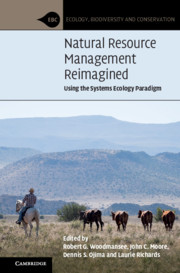Book contents
- Natural Resource Management Reimagined
- Ecology, Biodiversity and Conservation
- Natural Resource Management Reimagined
- Copyright page
- Contents
- Contributors
- Preface
- 1 The Systems Ecology Paradigm
- 2 Environmental and Natural Resource Challenges in the Twenty-First Century
- 3 Evolution of Ecosystem Science to Advance Science and Society in the Twenty-First Century
- 4 Five Decades of Modeling Supporting the Systems Ecology Paradigm
- 5 Advances in Technology Supporting the Systems Ecology Paradigm
- 6 Emergence of Cross-Scale Structural and Functional Processes in Ecosystem Science
- 7 Evolution of the Systems Ecology Paradigm in Managing Ecosystems
- 8 Land/Atmosphere/Water Interactions
- 9 Humans in Ecosystems
- 10 A Systems Ecology Approach for Community-Based Decision Making
- 11 Environmental Literacy
- 12 Organizational and Administrative Challenges and Innovations
- 13 Where to From Here? Unraveling Wicked Problems
- Index
- References
13 - Where to From Here? Unraveling Wicked Problems
Published online by Cambridge University Press: 25 February 2021
- Natural Resource Management Reimagined
- Ecology, Biodiversity and Conservation
- Natural Resource Management Reimagined
- Copyright page
- Contents
- Contributors
- Preface
- 1 The Systems Ecology Paradigm
- 2 Environmental and Natural Resource Challenges in the Twenty-First Century
- 3 Evolution of Ecosystem Science to Advance Science and Society in the Twenty-First Century
- 4 Five Decades of Modeling Supporting the Systems Ecology Paradigm
- 5 Advances in Technology Supporting the Systems Ecology Paradigm
- 6 Emergence of Cross-Scale Structural and Functional Processes in Ecosystem Science
- 7 Evolution of the Systems Ecology Paradigm in Managing Ecosystems
- 8 Land/Atmosphere/Water Interactions
- 9 Humans in Ecosystems
- 10 A Systems Ecology Approach for Community-Based Decision Making
- 11 Environmental Literacy
- 12 Organizational and Administrative Challenges and Innovations
- 13 Where to From Here? Unraveling Wicked Problems
- Index
- References
Summary
The evolution of ecosystem science and systems ecology as legitimate branches of science has occurred since the late 1960s. They have flourished because of their essential contributions to understanding and management of natural resources and the environment. Scientific knowledge about the structure and functioning of ecosystems, the services ecosystems provide to people, and the roles people play therein, have become commonplace. Scientists know what challenges face Earth’s environments and they know many of the solutions available to resolve them. But scientific knowledge alone is insufficient to implement change. Knowledge transfer to people who manage our lands, waters, and other natural resources is essential and they must become engaged in implementing solutions to major natural resource and environmental challenges. Adoption of new concepts and technologies is critical. Overcoming the barriers to adoption of best management practices is critically needed. Many of the barriers are created by adherence to dogmatic cultural norms and ideologies by landowners, managers, and policy makers. Behavioral, organizational, learning, and marketing professionals study behavioral change. The systems ecology paradigm must incorporate behavioral, organizational, learning, and marketing professionals as partners in implementing concepts of adoption cycles and community-based social marketing to solve wicked problems.
Keywords
- Type
- Chapter
- Information
- Natural Resource Management ReimaginedUsing the Systems Ecology Paradigm, pp. 380 - 420Publisher: Cambridge University PressPrint publication year: 2021
References
- 1
- Cited by

